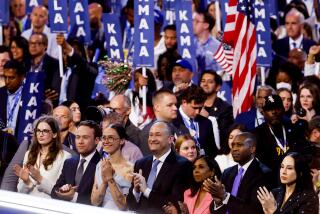President Obama: At odds with clear demographic trends toward multiracial pride
It could have been a historic teaching moment. Instead, President Obama, the most famous mixed-race person in the world, checked off only one race — black — last year on his census form. And in so doing, he missed an opportunity to articulate a more nuanced racial vision for the increasingly diverse country he heads.
The president also bucked a trend. Last month, the Census Bureau announced that the number of Americans who identified themselves as being of more than one race in 2010 grew about 32% over the last decade. The number of people who identified as both white and black jumped an astounding 134%. And nearly 50% more children were identified as multiracial on this census, making that category the fastest-growing youth demographic in the country.
To be sure, the number of people — 9 million, or 2.9% of the population — who identified themselves as of more than one race on their census form is still small. But the trend is clear.
It has been only since 2000 that the federal government allowed Americans to identify themselves as of more than one race, and the change was one more step away from the sordid days when racial mixing was frowned on and even criminalized in much of the country. The increase in the number of Americans who now identify as racially mixed suggests not only an increase in absolute numbers, but also that people are growing more comfortable with the idea of racial mixing.
Through much of the 20th century, the notion of racial purity was ingrained in the legal system of many states and used as a tool to uphold white supremacy. Some states even passed laws codifying the “one-drop rule,” which held that anyone with the slightest hint of African ancestry would be considered black. Such laws reinforced racial segregation and helped maintain whites’ place at the top of the hierarchy. The conflation of race purity with superiority also led to a societal prejudice against interracial relationships, though it never fully stopped people from mixing across racial lines. Pennsylvania State University geneticist Mark Shriver has estimated that a majority of African Americans today have at least 12.5% European ancestry, the equivalent of one white great-grandparent. Social pressure, however, discouraged people from acknowledging this.
Over the last several decades, a number of trends — the civil rights movement; the softening of racial lines; the abolishment of anti-miscegenation laws; the growth in the Mexican-origin population, which has its own long history of racial mixing; and the Census Bureau’s check-all-races-that-apply decision — have led to a growing acceptance of multiracialism in the U.S.
Given the history of the one-drop rule and Obama’s own mixed-race origins, one would’ve thought he would have proudly checked more than one box. Indeed, a large part of candidate Obama’s appeal was the facility with which he could communicate across racial lines. His decisive victory in the 2008 presidential election was widely interpreted as having moved the nation toward a less racially polarized future.
Obama hasn’t discussed his reason for choosing to identify as black only, but others have offered reasons why people of mixed-race might choose to identify only one piece of their heritage.
Some black civil rights activists have opposed the very idea of allowing Americans to identify as multiracial, concerned that their strength would be diminished if it appeared that their numbers were diminishing. And researchers have expressed the fear that they will lose a useful tool for monitoring racial discrimination. While the system of racial labeling was long used as a tool of dominance, in the last 40 years, race data have also been used to analyze the prevalence of racism. As Harvard scholar Kim Williams has written, “The civil rights movement turned the previously oppressive function of racial data on its head.”
Obama’s somewhat tenuous hold on blackness — he was raised by a single white mother and white grandparents — also probably shaped his decision. There were questions raised about whether he was “black enough” in his early political career in Chicago. While he could have embraced the easy recognition of racial mixture that characterizes his home state of Hawaii, he chose instead to identify firmly on one side of the historic racial divide.
“Obama made the politically correct choice,” San Francisco State University political scientist Robert C. Smith told me last week. “If he had come to Chicago calling himself multiracial, he would have had no political career. And I think if he called himself multiracial now, black people would see it as a betrayal.”
For all the post-racial symbolism millions of Americans have projected onto the president, his political choices are at odds with emerging demographic trends. America will just have to find its way into the new multiracial era without him.
More to Read
Sign up for Essential California
The most important California stories and recommendations in your inbox every morning.
You may occasionally receive promotional content from the Los Angeles Times.










